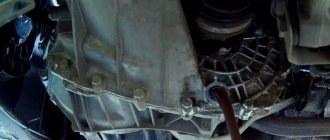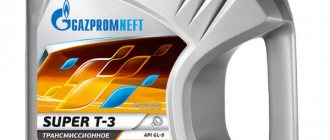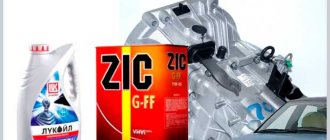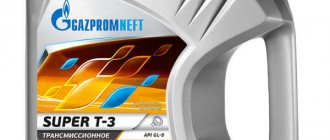The frequency of changing the oil in the gearbox depends not only on the model and type of transmission, but also on the year of manufacture of the car. For example, on Niva every 40 thousand km, and on front-wheel drive LADA every 80-180 thousand km). Let's figure out which gearbox oil is best to choose, and whether it can improve transmission performance and reduce howling.
| Gearbox model | Installed on the car | Oil volume |
| Manual transmission 2180 | Lada Kalina 2, Lada Granta, Lada Priora | 3.1 l |
| Manual transmission 21807 | Lada Vesta | 2.25 l |
| Manual transmission 2181 | Lada Kalina 2, Lada Granta, Lada Priora | 2.2 l |
| Automatic transmission (Jatco) Nissan | Lada Kalina 2, Lada Granta | 4.1-4.4 l |
| AMT 2182 | Lada Priora, Lada Granta, Lada Vesta, Lada XRAY | 2.25 l |
| Manual transmission JH3 (Renault-Nissan) | Lada Vesta, Lada XRAY | 2.34 l |
| Manual transmission JR5 518, JR5 523 | Lada XRAY | 2.2 l |
| Manual transmission JH3/JR5 (Renault-Nissan) | Lada Largus | 2.8/2.5 l |
Separately about
:
- Renault JH3 and JR5 transmission oils
- transmission oils Lada 4x4
- Niva Chevrolet transmission oils.
What transmission oils are recommended by AVTOVAZ ? If you open the Operating Manual for the vehicle and its modifications, not the latest edition, you can find table No. 4 “Transmission oils for gearboxes.” Comparing them for different Lada cars, you can understand that AVTOVAZ recommends the same transmission oils for the Lada Granta/Kalina/Priora gearbox.
- LUKOIL TM-4 - 75W-80, 75W-85, 75W-90, 80W-85, 80W-90; TG-4
- NOVOIL TRANS KP - 80W-85; TG-4
- ROSNEFT KINETIC - 80W-85; TG-4
- TNK TRANS KP - 80W-85; TG-4
- TNK TRANS KP SUPER - 75W-90; TG-4
- TRANS KP-2 - 80W-85; TG-4
- SHELL TRANSAXLE OIL - 75W-90; TG-4/5
What brand of oil is in the manual transmission on Lada from the factory?
- For Lada Priora - Lukoil TM 4-12 (80W-85, 75W-90).
- On the Lada Kalina - Mineral TNK TRANS KP, TU 38.301-41-191-01, which is produced by the Ryazan Oil Refinery (the old name is ROLS T).
- On the Lada Granta - Lukoil TM 4 with a viscosity class depending on the region of operation of the car - 75W-80, 75W-85, 75W-90, 80W-85 or 80W-90. Since August 2012 Fill the front-wheel drive gearbox with transmission oil TATNEFTTRANSLUX 75W85 (semi-synthetics)
- On Lada Largus - ELF Tranself NFJ 75W-80 GL-4+.
- Gearbox 2180x (Lada Vesta and XRAY): semi-synthetic gear oil “Rosneft Kinetic Service” SAE 75W-85 API GL-4.
- JH3 gearbox (Lada Largus, Vesta and XRAY): transmission oil “TRANSELF TRJ (NFJ) 75W-80” SAE 75W-80 API GL-4+.
- Gearbox JH5 (Lada Largus, Vesta and XRAY): oil TRANSELF TRT 75W-80 TPM4501/B06138A.
Selecting the viscosity of the transmission oil:
| Minimum temperature for ensuring lubrication of components, oC | SAE viscosity grade | Maximum ambient temperature, oC |
| -40 | 75W-80 | 35 |
| -40 | 75W-85 | 35 |
| -40 | 75W-90 | 45 |
| -26 | 80W-85 | 35 |
| -26 | 80W-90 | 45 |
| -12 | 85W-90 | 45 and above |
What kind of oil is in the automatic transmission of Lada Granta and Kalina 2? Genuine EJ-1 ATF gear oil (supplied by JX Nippon Oil and Energy Corporation).
Which gear oil composition should I choose ? To answer this question, we conducted surveys among owners of Lada Grant, Lada Kalina and Lada Priora, asking them to answer the question “What composition of transmission oil do you use in your car” and as a result we received approximately the same results:
Which brand of gearbox oil should I choose?
The next polls and very similar results:
How to choose oil for a robot box (AMT) Lada Vesta
Gearbox markings on Lada Vesta:
- "GFL11" - mechanics;
- “GFL12” – robotic version (AMT);
- "GFL13" - mechanics from "Renault JH3 510".
The manufacturer always puts the symbol “ATF” on a canister of transmission fluid for a robotic gearbox. Based on the presence of this abbreviation, you can buy gearbox oil.
It is important to observe the seasonality of the liquid (summer, winter):
| Type | Viscosity grade | API class |
| Winter | 70 – 85 (ATF) | GL4 |
| Summer | 90 – 250 (ATF) | GL5 |
| All-season | 75 – 95 (ATF) | GL4/GL5 |
GQ7Q2455
Guess the maneuver
Unlike a hydromechanical gearbox, movement without warming up immediately after starting the engine at low temperatures is not so harmful for the robot. The AMT is also lighter and more economical than a traditional automatic. And significantly cheaper. You have to pay for these advantages with ease of traction control and comfort in transient conditions. And in the case of a single-disk robot, as on Vesta, also the speed of switching. For example, in gearboxes with two clutches (for example, DSG from Volkswagen), where different clutches are responsible for even and odd gears, gear changes occur almost instantly, without interrupting the power flow. After all, to do this, it is enough to open one clutch and close another with a pre-selected gear. And on Vesta, the automatic system acts like a driver when driving with a manual transmission: it opens the clutch discs, then changes gears and closes the clutch again. It takes noticeably longer to complete the circle.
If you have already driven a Kalina or Priora with a similar AMT, forget those feelings. For Vesta, the box was thoroughly reconfigured and equipped with an original control unit. Shifts have become smoother... and longer (1.7 s versus 1.43 s on Kalina). Loss of traction for such a period of time in a bustling stream is fraught, if not with an emergency, then at least with the urging horns of the drivers whom you have detained. However, you can select the manual control mode and work proactively, tuning the desired gear in advance. Or order a sticker on the rear window with the inscription Manual Transmission
in a triangle.
We jump into our Vesta and drive around the capital, and then go onto the country highway. Halfway through, we change cars with a colleague to neutralize the influence of driving style. So, the average fuel consumption on Vesta with AMT was 9.4 l/100 km, and the trip computer of the mechanical Vesta gave 9.9 l/100 km. In traffic jams the situation is reversed. Can't you trust electronic readings? Well, if she’s lying, she’s lying in the same way.
Another thing is interesting: for 100 manual transmission shifts, the AMT indicator changed the number of the selected gear 117 and 122 times, depending on the driver. The difference is due to the fact that during decelerations the robot sequentially switches gears until the car comes to a complete stop. However, you don’t feel the switching itself, and the tachometer needle remains stationary until the driver touches the accelerator pedal. But if you go “down” in manual AMT control mode, you can brake with the engine.
Trophy
Having driven the Vestas onto the lift, we discovered other design differences. The engine, paired with French mechanics, has a cast sump, which is attached to the cylinder block and to the clutch housing. This made it possible to increase the rigidity of the entire structure. And the robot got a standard VAZ stamped pan, not connected to the clutch housing.
And the clearance varies. On a three-pedal Vesta, from the asphalt to the drain plug of the engine oil pan is 190 mm. It's the same distance to the bottom of the box. The units of the robotic Vesta are suspended a little higher: there are 195 mm to the engine oil pan plug, and 200 mm from the robot to the ground. In both cases, the engine compartment is covered with a steel mudguard, the clearance under which is 185 mm.
Of course, we remember that in the comparative test of Vesta with its competitors, we measured 190 mm under protection, but on that pre-production car, tires measuring 205/55 R16 were installed. Serial Vestas are shod with different tires - 195/55 R16. Hence the difference in results.
The curb weight was also compared. Vesta with the robot turned out to be 20 kg lighter, and there are several reasons for this. The AMT gearbox is 2.2 kg lighter than the French manual and requires a little less oil. Like the power unit paired with a manual gearbox: it has a different oil pan, and the lubrication system holds 1.2 liters less oil. In addition, the mechanical Vesta has a heavier multimedia unit with navigation and a rear view camera included, while the robotic car has a simpler radio. And for some reason there was no protection for the rear wheel arches. Although both cars have similar Lux trim levels, with the exception of a few options. Just like that, little by little, I gained 20 kg.
I eat as much as I can
On the other hand, try going from second to first even at very low speed. I'm sure AMT will do it smoother than most manual drivers.
If necessary, for example when overtaking, the robot will easily jump down through a gear in both automatic and manual control modes. There is also a rocking function if the car is stuck.
What kind of liquid was added from the factory and in what volume?
To fill the automatic transmission with oil, you will need 2.2 liters. There are canisters on sale with a minimum volume of 1.0 liters, respectively, purchase three pieces, you will have some left over for refilling.
AvtoVAZ fills production models of Lada Vesta 1.6 (1.8) with transmission fluid of the TM-4-12 SAE 76W-85 GL-4 class. This oil is semi-synthetic based, all-season, and contains a number of imported additives to improve performance properties.
Gear oil for manual transmissions
The grease is intended for use in the temperature range from -40°C to + 40°C. Exceeding the limits contributes to a change in the molecular composition of the liquid and a decrease in quality. Experts do not recommend refilling mineral-based gear lubricant, since it is characterized by a smaller temperature range and poor quality of chemical additives and components.
Related link:
Test drive - Lada Vesta
What does oil viscosity affect?
The viscosity of transmission oil has a great influence on the vehicle's gearbox. With high viscosity, delays in gear shifting may occur, the sliding time of gearbox components increases, which increases wear, but reduces the noise of the gearbox. Oil, on the contrary, with low viscosity, is not able to create a strong film between surfaces. So, if it is destroyed, the elements begin to work “dry”, which contributes to wear.
You can easily feel the viscosity of the oil in winter at very low temperatures when starting the car.
Changing the oil in a robot is a bit of a difficult task, because... the factory did not provide for this operation. To replace, you will need a large syringe for pumping oil. Home page
Review of Manufacturer Prices
| Name / article / viscosity grade | Price in rubles (liter) |
| Mobile 1 SHC (75W/90) | From 650 |
| Lukoil TM-5 (75W/90) | From 370 |
| Castrol Suntrans Transaxle (75W/90) | From 550 |
| Mobile GX (80W) | From 600 |
| Lukoil TM-5 (85W/90) | From 350 |
| Lukoil PSNT (75W/90) | From 350 |
*prices are as of March 11, 2019.
Is washing necessary, which one to choose?
It is necessary to flush an automatic transmission:
- after long-term operation with old oil;
- when replacement deadlines are delayed;
- frequent use of equipment under load.
Tranself 75W-80
In all other cases, it is enough to limit yourself to the usual replacement according to the “drain-fill” principle. However, the manufacturer does not prohibit washing the “robot” every time the fluid is changed. The decision is made by the car owner individually.
How to choose oil for a manual transmission
Choosing a lubricant for a manual gearbox is even simpler than for an automatic transmission, since you don’t need to look for canisters with the abbreviation “ATF”.
By default, the manual transmission box is filled with semi-synthetic oil, TM-4-12 SAE 76W-85 GL-4.
Volume: 2.35 liters.
Temperature range: from -40°С to + 45°С.
The manufacturer allows liquids to be filled with a synthetic base, but is categorical about a mineral base due to its low quality.
Analogues of factory lubricant:
| Name / article / viscosity grade | Price in rubles (liter) |
| ZIC GFT (75W-85), synthetic | From 410 |
| Motul (75W-80), synthetic | From 370 |
| Liqui Moly LM Getriebeoil (75W-90), semi-synthetic | From 450 |
| ZIC G-FF (75W-85), semi-synthetic | From 380 |
| TRANSELF NFJ (75W-80), synthetic | From 350 |
| Hochleistungs-Getriebeoil (75W-90), synthetic | From 420 |
Related link:
Refinement of Vesta - what needs to be done right away
*prices are as of March 11, 2019.
Is washing necessary, which one to choose?
The decision on the need for flushing is made by the service station technician, who conducts a routine inspection. It must be based on the actual mileage of the car, the date of the last replacement.
Obviously, purchasing flushing lubricant entails additional costs. Not every owner agrees to this. In order to increase the service life of the gearbox, clean it efficiently, and remove metal shavings, make it a rule to use flushing constantly.
Technical characteristics of popular Liqui Moly oils
Since the company’s product range is very extensive and continues to expand, it makes sense to provide a description of the features and technical characteristics of the most popular oils for different types of transmissions.
Hochleistungs-Getriebeoil 75W80
Hochleistungs-Getriebeoil 75W80 oil is intended for use in robotic preselective gearboxes. Provides quick engagement and disengagement of friction clutches, optimal functioning of hydraulic servos, high-quality lubrication of synchronizers, gears and other transmission parts. Features of Hochleistungs-Getriebeoil 75W80 liquid:
- almost ideal viscosity-temperature properties;
- excellent shear stability;
- high wear resistance;
- excellent antioxidant properties, resistance to aging.
Specifications:
- viscosity index at a temperature of 40° C – 33.00 mm2/s;
- viscosity index at 100° C – 6.85 mm2/s;
- viscosity index at a temperature of -40° C – no more than 20,000 mPas;
- ignition temperature – 200° C;
- critical crystallization temperature – minus 48° C.
Top Tec MTF 75W80
Top Tec MTF 75W80 oil is used in mechanical gearboxes, power take-off units and transfer cases. Recommended for use in manual transmissions from most well-known car manufacturers. It is characterized by a high degree of protection of transmission components from wear.
Features of Top Tec MTF 75W80 fluid:
- ensuring fuel efficiency;
- excellent anti-corrosion properties;
- resistance to high loads;
- decent viscosity-temperature parameters;
- ensuring optimal operation of synchronizers.
Specifications:
- viscosity index at a temperature of 40° C – 53.60 mm2/s;
- viscosity index at 100° C – 9.30 mm2/s;
- viscosity index at a temperature of -40° C – no more than 150,000 mPas;
- ignition temperature – 202° C;
- critical crystallization temperature – minus 45° C.
Getriebeoil 85W90
Getriebeoil 85W90 is a GL4 class mineral transmission fluid intended for use in manual transmissions of trucks and passenger vehicles. It is characterized by the use of base mineral components of the highest quality and a complex of additives and modifiers that ensure clear and fast gear shifting.
Features of Getriebeoil 85W90 oil:
- possibility of use in gearboxes with all types of bevel and cylindrical gears;
- full compatibility with all modern seals;
- all-season use.
Recommendations for choosing gearbox oils and flushes
Provided that the equipment is used moderately, a non-aggressive driving style, acceptable temperature conditions, and the properties of domestic lubricant are more than enough to ensure the functioning of the gearbox.
It is rational to refuel imported analogues in case of active use of the car at high speeds, at elevated temperatures, or in an aggressive driving style. European and American oils are better adapted for extreme sports.
Conclusion
When choosing gear oil for a Lada Vesta car, be extremely careful with the markings. Do not confuse “mechanics” with “automatic”.
Among manufacturers, give preference to domestic analogues. They are identical in quality and set of characteristics to imported ones, but the price is 10–15% cheaper. If you have any difficulties with choosing a lubricant or marking the type of transmission, contact service station technicians or auto shop managers for help. Additionally, check out the recommendations on the Internet.
Why does liquid waste its potential?
The lubricant contains the main component of oil refining and a set of specialized additives. During operation of the machine, the liquid gradually loses the necessary characteristics and reduces efficiency indicators, which leads to the following negative changes:
- the appearance of unpleasant noise or knocking;
- structural parts lose their properties;
- the mechanism begins to spontaneously switch off gears or does not work quite clearly;
- The main gear and additional elements may fail.
The operating time of transmission oil directly depends on the driving habits of the car. The service life can be halved if the owner allows himself to be aggressive on the roads, starting with slipping. This puts significant pressure on gearbox components and leads to their rapid wear.
Reviews
| № | Positive |
| 1. | Vasily , 34 years old (drive2.ru): changed the lubricant on the mechanics for the first time at 20,000 km. The color is brown, there are not a lot of metal shavings. I filled in the same thing - factory semi-synthetic from Lukoil. |
| 2. | Dmitry Mikhailovich , 46 years old (prom.ua): the mileage of the Lada Vesta is 52,000 km, the condition of the manual transmission lubrication is still good, but it is advisable to “update”. I bought three liters of Rosneft, semi-synthetic, as part of the promotion. |
| 3. | Alexey , 36 years old (drom.ru): I have no complaints about the machine, it works properly. Total mileage 35,000 km. I regularly visit service stations, carry out diagnostics, and buy original consumables. |
| 4. | Petrovich , 47 years old (rozetka.ua): I renewed the lubricant for the first time at 2000 km, after purchasing it from the dealership. The color of the liquid was natural, there were practically no shavings. After filling it with Rosneft on a synthetic basis, my comrades advised. |
| 5. | Vyacheslavovich , 48 years old (Auto.ru): did not wait for 75,000 km, as recommended by the manufacturer, updated the “lubrication” in the mechanics already at 50,000 km. The box is working normally, there are no comments. |
| 6. | Semyon Vasilyevich , 44 years old (Auto.Mail.Ru): for three years of active use of the car there were no breakdowns, only scheduled technical inspections. I take good care of my equipment, observe the replacement intervals for consumables, and have a moderate driving style. |
| 7. | Dmitry Stepanovich , 47 years old (drive2.ru): The Lada Vesta is five years old and has never changed the oil in the box. The manufacturer recommends I won’t wait at 75,000 km, I’ll update at 60,000 km. I don't think it will get any worse. |
| 8. | Andrey Sergeevich , 49 years old (drive2.ru): I have an old Vesta, still mechanically from the French. Over five years of active use, I replaced the transmission fluid twice. There are no complaints about the manual transmission, it works normally. |
| Negative | |
| 9. | Gennady Dmitrievich , 53 years old (prom.ua): a rustling sound appeared at idle, after diagnostics in the workshop they said that it was necessary to replace the bearing in the box. The car is only three years old, but it already requires investment. |
| 10. | Vladimir , 48 years old (Bibika.ru): problems with the transmission began after several thousand miles. There was noise when moving, slight vibration. I will go to a service station for diagnostics followed by repairs. |
| 11. | Boris Sergeevich , 48 years old (drive2.ru): over the four years of using the car, I have already contacted the service center several times to troubleshoot the machine. Frequent delays (pauses) when switching, vibration when moving. |
| 12. | Sergey Vasilievich , 47 years old (Avtodispatcher.ru): changed the oil unscheduled, at 30,000 km. Already at that time the grease was dark brown in color. Which indicates the low quality of the oil. I filled it with imported Mobile, my garage mates recommended it. |
Related link:
Do-it-yourself seat heating repair on Lada Vesta
Step-by-step process for replacing Vesta engine fluid
We mean that changing the oil in the engine of a modern domestic Lada Vesta car begins with dismantling the plastic that covers the engine.
Next, remove the cover of the so-called neck where the oil is poured, and dismantle the plastic shield located at the bottom of the motor, thus protecting it from dust and dirt. This shield is fastened with 13 ordinary bolts, which have 10 heads.
The next step is to clean the oil pan, exactly where the plug from the drain neck is located; also, using a regular hexagon 8, we unscrew the plug itself.
We remind you that before these manipulations you should place some convenient unnecessary container, for example a basin, under the special drain neck, because it is from there that the used oil will be drained. Let us add that you also need to be careful in this matter, because the oil is quite hot and if it gets on your skin, it can cause burns.
It is necessary to drain the engine fluid until it stops dripping from the specialized drain hole. After that, use a piece of clean cloth to wipe off the dirt that has accumulated on the plug and screw it into its rightful place. Plus, do not forget to remove any oil stains that have formed from the surface of the crankcase.
Already at the next stage of replacement, it is necessary to install an unnecessary container for used motor fluid where the oil filter is located, because when the oil is changed in the car, it is obvious that replacing the filter is mandatory. To replace the filter we have designated, you need to disconnect the wiring harness coming from it from the crankshaft sensor, and carefully move it aside so as not to damage it in any way.
It is not necessary to remove the sensor itself at all, but in this case you will have limited space to work, therefore, if you are uncomfortable, then you will have to remove the above mentioned sensor.
To remove the sensor, use a 10mm wrench. Take a pre-prepared chain puller and use it to loosen the filter. After which it can be easily unscrewed and thus removed.
Then we take a new oil filter and carefully pour fresh oil into it, approximately 50 percent of its capacity. You should also carefully lubricate the o-ring of the filter itself with fresh oil and screw it into place, but remember that before installing the new oil filter, its seat must be cleaned of dust and dirt. Then, when the new oil filter is correctly installed, it must be screwed in until the cylinder block directly contacts the so-called O-ring located on the filter, and then turned another 75 percent of a turn
And after this the oil is filled. And here a logical question arises: how much oil to pour into the car engine? We answer, for the domestic car LADA Vesta, the optimal oil level directly for filling is 4.4 liters
Then, when the new oil filter is correctly installed, it must be tightened until the cylinder block directly contacts the so-called sealing ring located on the filter, and then turn another 75 percent of a turn. And after this the oil is filled. And here a logical question arises: how much oil to pour into the car engine? We answer, for the domestic car LADA Vesta, the optimal oil level directly for filling is 4.4 liters.
We also add that not all car owners have a chain puller, and therefore, if you don’t have one, you can use the following method: drive a screwdriver into the old used filter and directly use it as a kind of lever for unscrewing the filter
The most important thing here is not to damage the engine fitting in any way. In addition, remember that the engine in this car with AMT has a slightly smaller volume of motor fluid
How much oil should I pour into the engine in this case? 3.2 liters.











